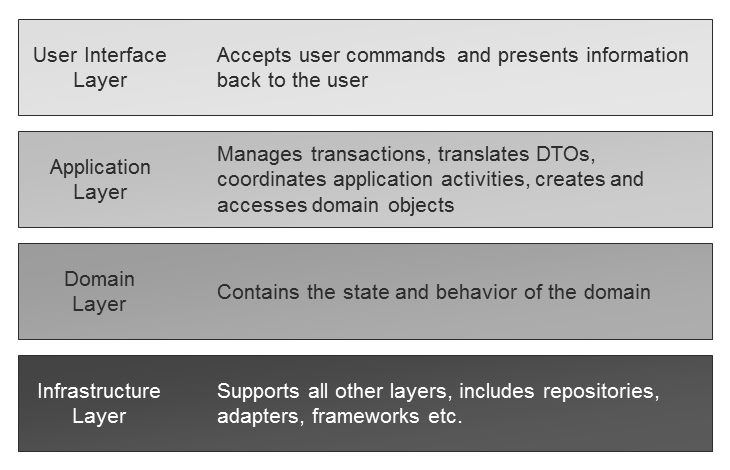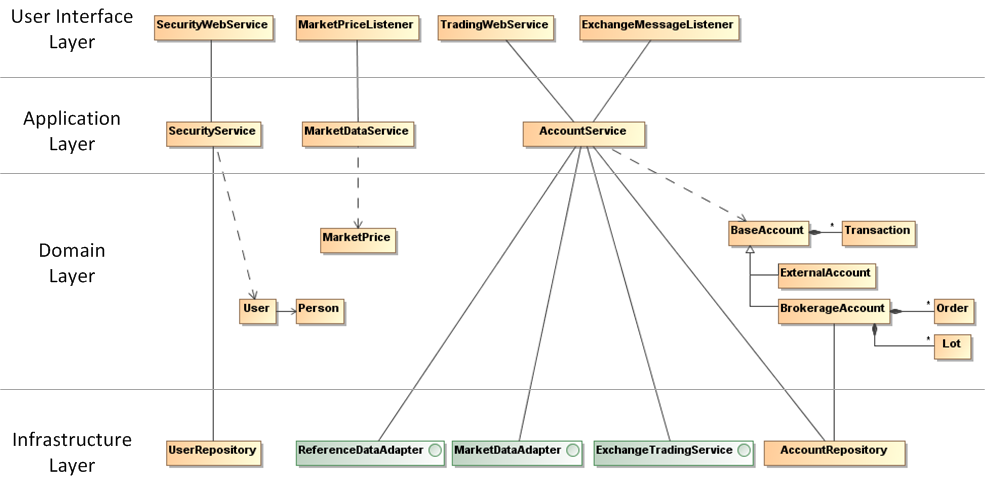6. Domain-Driven Design – Layered Architecture
Now let’s zoom into the Bullsfirst OMS and discuss DDD as it relates to a single bounded context. The first concept we’ll talk about is called Layered Architecture.
In general, to create a full-fledged software application we will have to implement a lot more than just the domain model – user interface, database access and external service adapters are just a few examples. If we start implementing these elements without much thought to their organization, we will soon have a ball of mud, with business logic intermingled with UI and data access code. This is bad because even a minor enhancement will require careful tracing of the entire application.
Creating applications that can handle very complex tasks requires separation of concerns. This is where the concept of a Layered Architecture comes in. The basic idea is to structure an application into four conceptual layers:

How does Bullsfirst OMS implement these layers? Here’s a high level overview

User Interface Layer
The OMS does not have a user interface. However, it exposes four services that allow other applications to interact with it:
- SecurityWebService provides user registration and authentication for front-end clients
- TradingWebService provides trading related functions such as order and account management
- MarketPriceListener listens to the exchange for market price change messages
- ExchangeMessageListener listens to the exchange for order status change messages
In the context of layered architecture, these four services provide the “user interface” for external applications – they translate incoming requests to method calls for the application layer and in the case of web services, translate the return values to SOAP responses. In addition, this layer is also responsible for transaction management by starting transactions for every service call.
Application Layer
The application layer is responsible for creation and retrieval of domain objects, as well as calling their methods to satisfy user commands. The Bullsfirst OMS application layer consists of three services: SecurityService, MarketDataService and AccountService. Each service receives commands and queries from the layer above and in turn interacts with the domain layer to perform requested actions. Let’s look at the following AccountService method as an example:
public void cancelOrder(String username, Long orderId) {
// Check authorization on account
Order order = brokerageAccountRepository.findOrder(orderId);
checkAccountAuthorization(
getUser(username),
order.getAccount().getId(),
BrokerageAccountPermission.Trade);
// Cancel order
order.pendingCancel(orderEventPublisher);
exchangeTradingService.cancelOrder(order);
}
Note that the parameters to the method (username and orderId) are value objects.
That’s because the layer above (the User Interface layer) does not have domain
objects – all it has are some values sent by the client. Looking inside the
method you will find that the value objects are used to fetch the real Order
and call its pendingCancel method. You will also notice that the method has
access to the brokerageAccountRepository which is part of the infrastructure
layer. As we’ve now seen, the Application layer coordinates application activity
by retrieving domain objects and calling their methods.
Domain Layer
We will look at this layer in more detail in the next section.
Infrastructure Layer
This layer consists of:
- User and Account repositories for managing users and accounts in the database
- Adapters for accessing reference data and market data from the exchange
- TradingService proxy for sending trading commands to the exchange
Navigation
- Introduction
-
Ubiquitous Language
-
Domain Model
-
Bounded Context
-
Command-Query Separation
- Layered Architecture
-
Domain Layer
-
Conclusion